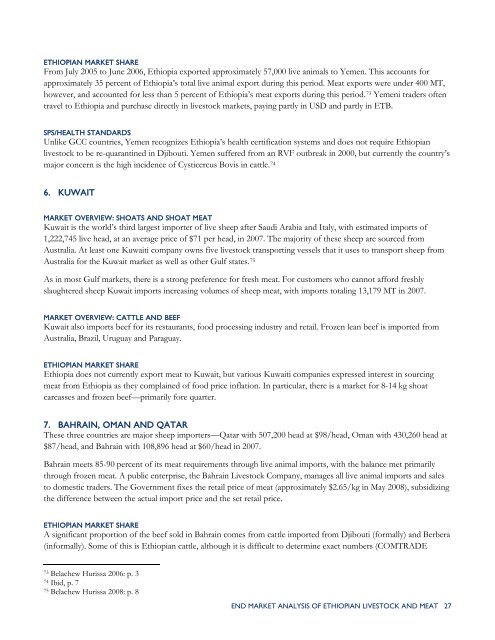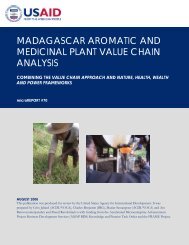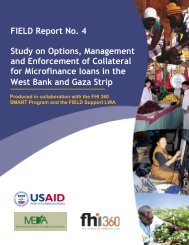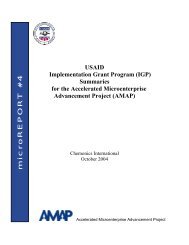End Market Analysis of Ethiopian Livestock and ... - USAID Microlinks
End Market Analysis of Ethiopian Livestock and ... - USAID Microlinks
End Market Analysis of Ethiopian Livestock and ... - USAID Microlinks
Create successful ePaper yourself
Turn your PDF publications into a flip-book with our unique Google optimized e-Paper software.
ETHIOPIAN MARKET SHARE<br />
From July 2005 to June 2006, Ethiopia exported approximately 57,000 live animals to Yemen. This accounts for<br />
approximately 35 percent <strong>of</strong> Ethiopia’s total live animal export during this period. Meat exports were under 400 MT,<br />
however, <strong>and</strong> accounted for less than 5 percent <strong>of</strong> Ethiopia’s meat exports during this period. 73 Yemeni traders <strong>of</strong>ten<br />
travel to Ethiopia <strong>and</strong> purchase directly in livestock markets, paying partly in USD <strong>and</strong> partly in ETB.<br />
SPS/HEALTH STANDARDS<br />
Unlike GCC countries, Yemen recognizes Ethiopia’s health certification systems <strong>and</strong> does not require <strong>Ethiopian</strong><br />
livestock to be re-quarantined in Djibouti. Yemen suffered from an RVF outbreak in 2000, but currently the country’s<br />
major concern is the high incidence <strong>of</strong> Cysticercus Bovis in cattle. 74<br />
6. KUWAIT<br />
MARKET OVERVIEW: SHOATS AND SHOAT MEAT<br />
Kuwait is the world’s third largest importer <strong>of</strong> live sheep after Saudi Arabia <strong>and</strong> Italy, with estimated imports <strong>of</strong><br />
1,222,745 live head, at an average price <strong>of</strong> $71 per head, in 2007. The majority <strong>of</strong> these sheep are sourced from<br />
Australia. At least one Kuwaiti company owns five livestock transporting vessels that it uses to transport sheep from<br />
Australia for the Kuwait market as well as other Gulf states. 75<br />
As in most Gulf markets, there is a strong preference for fresh meat. For customers who cannot afford freshly<br />
slaughtered sheep Kuwait imports increasing volumes <strong>of</strong> sheep meat, with imports totaling 13,179 MT in 2007.<br />
MARKET OVERVIEW: CATTLE AND BEEF<br />
Kuwait also imports beef for its restaurants, food processing industry <strong>and</strong> retail. Frozen lean beef is imported from<br />
Australia, Brazil, Uruguay <strong>and</strong> Paraguay.<br />
ETHIOPIAN MARKET SHARE<br />
Ethiopia does not currently export meat to Kuwait, but various Kuwaiti companies expressed interest in sourcing<br />
meat from Ethiopia as they complained <strong>of</strong> food price inflation. In particular, there is a market for 8-14 kg shoat<br />
carcasses <strong>and</strong> frozen beef—primarily fore quarter.<br />
7. BAHRAIN, OMAN AND QATAR<br />
These three countries are major sheep importers—Qatar with 507,200 head at $98/head, Oman with 430,260 head at<br />
$87/head, <strong>and</strong> Bahrain with 108,896 head at $60/head in 2007.<br />
Bahrain meets 85-90 percent <strong>of</strong> its meat requirements through live animal imports, with the balance met primarily<br />
through frozen meat. A public enterprise, the Bahrain <strong>Livestock</strong> Company, manages all live animal imports <strong>and</strong> sales<br />
to domestic traders. The Government fixes the retail price <strong>of</strong> meat (approximately $2.65/kg in May 2008), subsidizing<br />
the difference between the actual import price <strong>and</strong> the set retail price.<br />
ETHIOPIAN MARKET SHARE<br />
A significant proportion <strong>of</strong> the beef sold in Bahrain comes from cattle imported from Djibouti (formally) <strong>and</strong> Berbera<br />
(informally). Some <strong>of</strong> this is <strong>Ethiopian</strong> cattle, although it is difficult to determine exact numbers (COMTRADE<br />
73 Belachew Hurissa 2006: p. 3<br />
74 Ibid, p. 7<br />
75 Belachew Hurissa 2008: p. 8<br />
END MARKET ANALYSIS OF ETHIOPIAN LIVESTOCK AND MEAT 27





